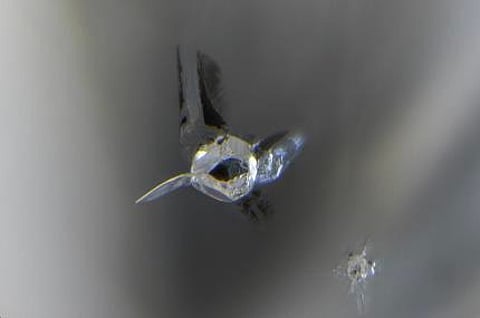

No one has ever visited the depths of our planet. However, a team of researchers from GIA and other institutions were able to gain incredible insight into the deep mantle – 660 km below the surface – by examining a diamond that in fact did ride a volcanic eruption to the surface.
Led by Dr. Tingting Gu, a GIA post-doctoral research fellow at the time of the research and now at Purdue University, the researchers, including GIA’s vice president of research and development Dr. Wuyi Wang, examined an exceptionally rare type IaB diamond from the Karowe mine in Botswana. The 1.5 ct, D-color diamond’s inclusions, examined using advanced, non-destructive methods including FTIR, Raman spectroscopy and X-ray diffraction, revealed that water can be found at least across the earth transition zone (410 – 670 km deep) and into the lower mantle (more than 670 Km deep).
When the diamond was submitted to GIA for evaluation – GIA sees millions of diamonds every year – researchers were intrigued by its unusual inclusions. These turned out to be very rare hydrous (water-bearing) minerals, suggesting the presence of water far deeper in the earth than previously believed.
Speaking about the research, Dr. Wang said, “Mineral inclusions in diamonds are the only materials from the earth’s interior that we can analyze directly. The study of these minerals offers unique opportunities to understand the chemistry of the Earth’s interior. GIA has been actively contributing to this fundamental research.”
The Richard T. Liddicoat Postdoctoral Research Fellowship program, created in 2014 in honor of GIA’s former president, who was widely considered the “Father of Modern Gemology,” gives researchers who study mineralogy, geology, physics, materials science and other fields related to gemology access to GIA’s gemological data, equipment and the rare, unusual and large gems that come into the laboratories.
The paper was published in late September in the scientific journal Nature Geoscience – you can see an abstract here. Popular Science magazine published an article about the paper on September 27.
In addition to Gu and Wang, a large team from GIA contributed to the research, including research scientists and technicians, photomicrographers, executives and GIA board members.
Follow DiamondWorld on Instagram: @diamondworldnet
Follow DiamondWorld on Twitter: @diamondworldnet
Follow DiamondWorld on Facebook: @diamondworldnet
